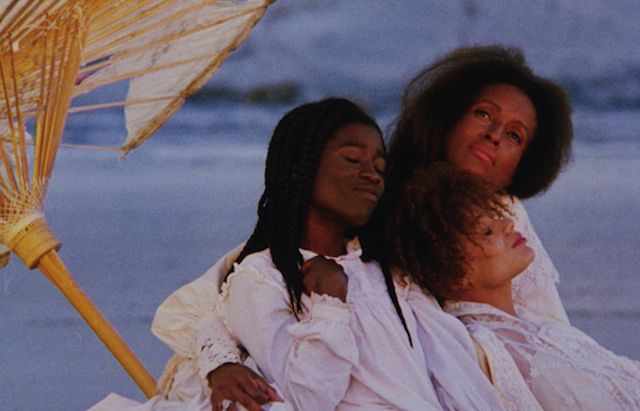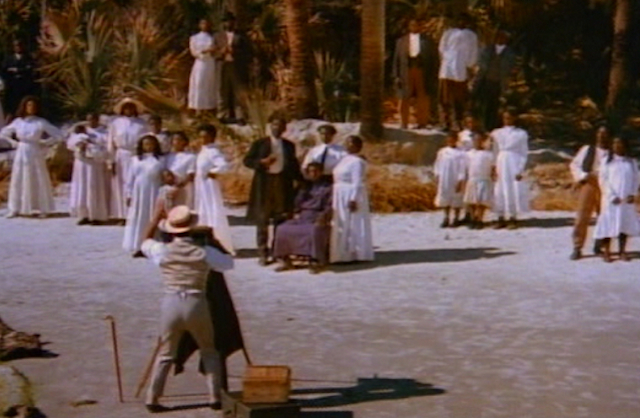CHICAGO – Patrick McDonald of HollywoodChicago.com appears on “The Morning Mess” with Dan Baker on WBGR-FM (Monroe, Wisconsin) on March 21st, 2024, reviewing the new streaming series “Manhunt” – based on the bestseller by James L. Swanson – currently streaming on Apple TV+.
Interview: Director Julie Dash of ‘Daughters of the Dust’
CHICAGO – Iconic and historical are the two apt terms for a film directed by an African American woman, the first to be distributed theatrically, Was it the 1920s? 1940s? It had to be the 1970s. No, it was 1992 when that barrier was broken, with the film “Daughters in the Dust,” directed by Julie Dash.
“Daughters of the Dust” is a lyrical cinematic poem about transition and pride. In the early 20th Century, the children of slaves were making their first movements from the South during “The Great Migration” – when African Americans sought more independence in the industrial North. “Daughters” highlights the residents of St. Simons Island in Georgia, a settlement for a freed family named Peazant – who practiced Creole “Gullah” ancestry, which observed African tribal traditions during their time in America. The older and more established residents are wary of the traveling ways of the new generation, and the presence of modernity like bicycles and photography foreshadows a yearning for more of the outside world. Narrated by two characters – one known as the “Unborn Child” – the film plays like a saturated postcard, portraying both lush scenery and unwavering consequence.

’Daughters of the Dust,’ Directed by Julie Dash
Photo credit: Cohen Media Group
Julie Dash had the idea for the film in the 1970s. After having success with documentaries, she got noticed for her first narrative film called “Illusions” (1982). After bouncing around in the film business, she secured financing for “Daughters” from PBS in 1988. It won a cinematography award at the Sundance Film Festival in 1991, before getting a theatrical release the following year. In 2004, the film was designated for preservation by the U.S. National Film Registry at the Library of Congress.
HollywoodChicago.com got the opportunity to talk to Julie Dash at the Chicago International Film Festival in October, where “Daughters of the Dust” was screened as part of their Black Perspectives series. Currently, the film has two more days of a special theatrical run at the Gene Siskel Film Center in Chicago, part of its roadshow for the 25th Anniversary. For more information, click here.
HollywoodChicago.com: Julie, since the film was restored recently for its 25th anniversary. Did you oversee the restoration?
Julie Dash: No, the original cinematographer, Arthur Jafa, oversaw that project, the scanning and color timing. It was shot in 35mm, with the gate adjusted so it came out in Super 35. We were trying to “future proof” it, and I’m glad we did.
HollywoodChicago.com: Do you feel it was a proper restoration in the digital age? Were you happy with it?
Dash: I’m very happy with it, I hadn’t seen it look so good since the work print. We kept the negative, and struck two ‘answer’ prints – we couldn’t afford any further, because each of those answer prints were 20 thousand apiece. We never struck a ‘release’ print, and now it’s finally at that stage.
HollywoodChicago.com: How important was it, in the development of the film, for you to get the control that resulted in such a personal and powerfully visual expression? How much push back did you have to deal with?
Dash: Well, since it was an independent film, I didn’t get any push back at all. Lindsay Law was the Executive Producer of American Playhouse Theatrical Films, which was a branch of what PBS was doing on television. There were three films made – ‘Stand and Deliver,’ Matty Rich’s ‘Straight Out of Brooklyn’ and ‘Daughters of the Dust.’ What made that period so rich is that it was Law’s decision alone as Executive Producer, and I worked directly, but independently, with his development team. I had free reign, and I want to thank Lindsay Law again.
HollywoodChicago.com: What distinctive characteristics marked the Gullah ancestors, that you still notice to today, and what traditions that you learned as a child led up to the notion of preserving a bit of them on film?
Dash: One of the things that distinguishes them from other African Americans is that years ago, before the bridges were built to the South Sea Islands [Georgia] connecting them to Beauford, Charleston and Savannah, these people were isolated from the mainland. They were the descendants of slaves that worked the indigo and rice fields. After the Civil War ended, it was found that they had stayed closer to their African roots than their American ones – in the way they looked, talked, cooked and worshiped. They were foreign to the Yankee soldiers.
The government conducted the “Port Royal” experiment on St. Helen Islands, which was to see if the island people could be educated, to assimilate them more with the African Americans who were coming off the other state’s plantation. That was the beginning of the end of the ‘Gullah Geechee’ culture, because they were considered the lowest on the African American pecking order coming out of the Civil War. Even up to the 1960s, when I grew up, nobody wanted to be considered as Gullah Geechee. Even you were one, you didn’t want anybody calling you that. It was the N-word in all caps.

The Modern Life: A Scene from ’Daughters of the Dust’
Photo credit: Cohen Media Group
HollywoodChicago.com: Using an unborn child as a narrator is a pretty radical story device. What gave you that idea, and what did you want the unborn spirit to symbolize in the people who were making their decisions?
Dash: The inspiration was the birth of my daughter, actually, but when I was writing it I could feel the criticism from my screenwriting teachers from the American Film Institute and elsewhere. I knew I was going more than against the grain. Number one, you’re not suppose to have more than one narrator, and I had two people – the great-grandmother and a child not even born. It was an ancient to the future symbolism, with those two voices.
HollywoodChicago.com: In your research and your own family history, what do you think the greatest challenge those islanders had the 50 years after slavery, in the 1902 year ‘Daughters’ is set?
Dash: One of the questions I get all the time is, ‘why did they leave?’ Many scholars think they would have been better off if they had just stayed – the agrarian society would have been more fruitful than the urban ghettos. But nobody really knew that, and I wasn’t going to change the past. They were teased with modern society, like the umbrella, the newspaper and the Sears catalog. Those glimpses made the mainland society more glorified. It seemed like the best place ever, if only they could get off the island. We, as the audience, know that this is not true.
HollywoodChicago.com: Since ‘Daughters’ is 25 years old and so much has happened in the film industry since its release, would you anticipate that it would be a different film if it were made today, given the history we’ve been through since the making of it?
 Julie Dash for ‘Daughters of the Dust’ Photo credit: Cohen Media Group |
Dash: I don’t know…but story-wise, it certainly have been different because I’m way older. [laughs] I’m glad it was made back then, because for example if I had made it more direct, it would be less than what it is. It is what it is because it needed to be that at the time. It needed to feel like a foreign language film because their lives were foreign to outsiders, and outsiders were foreign to them. I get a lot of push back as to the way they looked, but it’s just because an audience had never seen these people in a movie before.
HollywoodChicago.com: Recently, ‘The Birth of a Nation’ director Nate Parker came under some criticism due to his past difficulties [acquitted of rape at an earlier age] and what he chose to depict in his film that was related to those difficulties. Do you think situations like that could influence critical and audience reception, and is that fair game to you?
Dash: I actually saw the film before I knew of the problem. I think the film should be based on its own merits, but I also think people should know about those past issues and consider it. It’s a finely crafted and powerful film, but also ‘no means no.’
HollywoodChicago.com: You were the first African American woman to achieve a theatrical film release in the 20th Century, in the mind-blowing year of 1992, over 100 years after film was invented. Where do you find the state of film making for persons of color in general, and women in particular?
Dash: It’s still difficult. Ava DuVernay [‘Selma’] has done wonders – she did more in six months with her TV show ‘Queen Sugar’ than the industry had done in over 100 years, simply by hiring women to direct the series – black women, asian women, white women – just women. That cannot be diminished, denied and the credit cannot be taken away. And she did it to advance other women directors. Kudos to her.
 | By PATRICK McDONALD |


